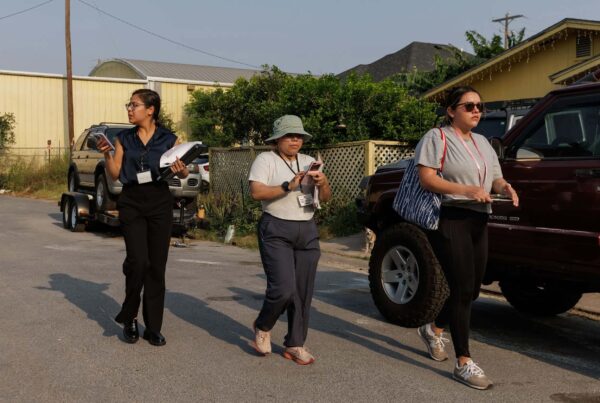From The Texas Tribune:
Texas Democrats and Republicans may be approaching a bipartisan consensus on how to tackle the state’s housing affordability crisis at a time when a majority of Texans say they spend too much money on keeping a roof over their heads.
The Texas Democratic Party over the weekend adopted a platform that includes calls to relax local zoning regulations that determine what kinds of housing can be built and where. Housing experts and advocates argue those rules drive up home prices and rents by preventing real estate developers from building enough homes to meet demand.
The platform calls for “ending racially motivated exclusionary forms of zoning which limit the supply of affordable housing options” and “undoing segregation era land use restrictions that divide communities, drive displacement, and fuel rising housing costs to this day,” among other measures intended to ease the state’s housing crunch.
“We wanted to make it clear what the stance of Democrats writ large is these days,” said Micah Erfan, a Houston housing advocate and Democrat who co-authored the platform language. “Amongst Democrats that are really interested in the issue of housing, it really generally is a very YIMBY (“yes in my backyard”) stance, a pro-housing stance, a stance that’s in line with President Biden: that the solution to the housing crisis is building more housing where people want to live.”
State lawmakers and policymakers across Texas cities have increasingly sought ways to rein in the state’s housing costs as high home prices freeze would-be homebuyers out of the market and tenants struggle to pay high rents. By various counts, Texas doesn’t have enough homes to absorb demand amid the state’s booming population growth — and that shortage has contributed to elevated home prices and rents.
Housing advocates and policy experts have increasingly placed a good chunk of the blame for that shortage on cities’ zoning regulations that regulate, among other things, how much land a single-family home must sit on and whether other kinds of housing like duplexes and small apartment buildings can be built alongside single-family homes. Such rules limit how many homes can be built and drive up housing costs as a result, they say.
Texas lawmakers entertained proposals to relax some of those local regulations last year — including bills that would’ve reduced cities’ minimum lot-size requirements for single-family homes and allow accessory dwelling units, also known as “granny flats,” in the backyard of single-family homes.
Those proposals failed but some of the state’s top Republicans, including Lt. Gov. Dan Patrick and House Speaker Dade Phelan, have signaled they would like to see some form of statewide zoning reform return to the Legislature next year. Other Texas Republicans, including Gov. Greg Abbott, have broadly become more vocal about finding ways to address the state’s affordability crisis.
A bipartisan approach is crucial to enacting any kind of housing reform at the state level, proponents say. A group of younger Democrats crafted the platform’s language on housing affordability in part out of antsiness that the party was ceding the issue entirely to Republicans, but also to try to give Democrats a road map on how to approach the housing crisis.
“Texas Democrats cannot just do nothing about the housing affordability crisis and let the Republicans run on it,” said Skyler Korgel, another co-author of the platform language on zoning.
At a recent meeting of the Texas Senate State Affairs committee, state Sens. Bryan Hughes, a Mineola Republican, and José Menéndez, a San Antonio Democrat, agreed they’d like to once more take up the granny flats proposal, which cleared the Senate.
The urgency to tackle the problem comes as more Texans are struggling with housing costs than in years past — which may give state lawmakers a mandate to tackle the housing affordability crisis head-on when they convene next year.
More than half of the state’s 4.2 million renter households spend too much of their income on keeping a roof over their heads, according to Harvard University’s Joint Center for Housing Studies. That finding echoes the results of a Texas Lyceum poll released last month, which shows that nearly two-thirds of Texans, homeowners and renters alike, say they spend too much on housing — compared with 44% of Texans four years ago.
That agreement crosses partisan lines, with 69% of Democrats and 61% of Republicans telling pollsters that housing costs take up too much of their budget.
“The problem of housing has become too big and widespread for members of either party to ignore,” said Joshua Blank, research director of the Texas Lyceum poll. “It doesn’t really matter whether you see your constituency as primarily urban, primarily suburban, or primarily rural: all three are facing a problem when it comes to housing costs. And ultimately, housing costs don’t discriminate by party.”
The idea of loosening local zoning regulations to allow more homes has proven to have bipartisan appeal elsewhere in the country. Blue states like California and Oregon and red states like Montana have enacted statewide zoning reforms in recent years to try to alleviate their states’ housing crises.
That appeal not only applies to the notion of lowering housing costs. Conservatives like the idea of loosening zoning rules to reduce government regulations and free up the market while also boosting individual property rights.
Liberals see loosening those same restrictions as a way to combat climate change: allowing more housing options closer to job centers, they say, would reduce commutes by car from far-flung suburbs.
They also see loosening those rules as a means to undo patterns of racial and economic segregation. Housing experts and advocates have argued that zoning restrictions adopted in the 20th century were a tool of racial segregation.
President Joe Biden has expressed support for easing local zoning rules in order to let more homes be built. The Austin City Council recently enacted a slate of local reforms intended to ease the affordability crisis — dramatically reducing its minimum lot-size requirements for single-family homes and allowing duplexes and triplexes to be built nearly anywhere single-family homes are allowed, among other changes. A coalition that included homebuilders, environmentalists, historic preservationists, business groups and the Texas arm of the AARP backed the reforms.
Opposition to zoning reform, too, is bipartisan. Republicans and Democrats alike count among their ranks Texans who have cultural attachments to the long-held notion of owning a single-family home on a large lot — and view efforts to allow other kinds of housing in their neighborhoods as an affront. Democrats also tend to resist zoning changes because they believe that doing so would accelerate displacement of lower-income residents and people of color from their neighborhoods — despite evidence to the contrary.
Despite the Texas Democratic Party’s embrace of zoning reforms, it remains to be seen whether Texas Democrats statewide will embrace the platform. After more than a decade of Republican lawmakers sapping authority from the state’s bluer urban areas, Democrats have tended to reject ideas that appear to take power away from cities.
House Democrats, in the minority, led a successful charge to kill last year’s granny flats proposal, in part because they felt cities should choose what kind of housing they allow, not the state. (The state ultimately grants cities their zoning authority.)
If cities don’t want to relax zoning restrictions and allow more housing, the state shouldn’t force them to, said Kendall Scudder, a Texas Democratic Party finance official who is skeptical of zoning reform.
“We are a ‘local control’ party,” Scudder said. “We believe that local governments know their communities best and we want to empower them to be able to make the zoning decisions that are best for them.”
For Erfan, enacting zoning reforms to allow more housing at the state level would be a better approach than waiting for the state’s housing crisis to be addressed one city at a time. A statewide change would come all at once, expediting a solution for an urgent issue, he said.
“Why would you prohibit the kind of housing options that people in my generation need in order to afford a place to live?” said Erfan, 20.
Disclosure: AARP and Texas Lyceum have been financial supporters of The Texas Tribune, a nonprofit, nonpartisan news organization that is funded in part by donations from members, foundations and corporate sponsors. Financial supporters play no role in the Tribune’s journalism. Find a complete list of them here.














